PCT Yearly Review
Download [PDF]
Table of Contents
- 1. INTRODUCTION
- 2. FILING OF PCT INTERNATIONAL APPLICATIONS
- 3. PERFORMANCE OF THE INTERNATIONAL PATENT SYSTEM
- 4. PCT AND THE ELECTRONIC ENVIRONMENT
- 5. DISSEMINATION OF PCT AND PATENT INFORMATION
- 6. CHANGES IN THE PCT LEGAL FRAMEWORK
- 7. PCT CONTRACTING STATES
- 8. MORE RESOURCES ON THE INTERNET
1. Introduction
In 2006, the international patent system saw several notable developments.
International patent application filings - The number of PCT international applications filed in 2006 grew by 7.9% compared to the previous year, to a total of 147,500 applications. The most significant growth has come from North East Asian countries, namely China, Japan and the Republic of Korea, which now account for 25% of applications filed. In 2006, 23% of the international applications published were classified in three technical fields: telecommunications, pharmaceuticals and cosmetics and information technology. International patent applications published in the field of semiconductors saw an increase of 28%, making this the fastest growing technical field 2006.
The move to an electronic environment - For the second consecutive year, more PCT international applications were filed on electronic media than on paper. Since 2006, the International Bureau and other Offices have been exchanging an increasing number of documents in electronic form. For newly received applications, the entire business flow within the International Bureau, from the receipt to the publication of international applications, has moved into a fully electronic environment.
Dissemination of PCT data through PatentScope - Since 2005 the PatentScope web portal has provided free access to all published PCT international applications, which now number more than 1.2 million. In 2006, additional features were added (RSS notification of new search results; graphical views of search results; more document types) and all publications are reclassified with the reformed International Patent Classification (IPC8) that came into force in January 2006. The number of PCT database pages viewed has tripled with about 12 million pages viewed in December 2006.
Additional Statistics - The International Bureau now publishes statistics on patent applications filed and granted since the signature of the Paris Convention for the Protection of Industrial Property in 1883 and patent applications filings - including PCT national phase entries - by country of origin in electronic format. In 2006, the International Bureau also published the WIPO Patent Report 2006, which provides statistics on worldwide patent activities.
The Patent Cooperation Treaty
The Patent Cooperation Treaty (PCT) offers inventors and industry an advantageous route for obtaining patent protection internationally. By filing one international patent application under the PCT, protection of an invention can be sought simultaneously in each of a large number of countries. Both applicants and patent offices of the 134 PCT Member States benefit from the uniform formality requirements, the international search and preliminary examination reports, and the centralized international publication provided by the PCT system. The national patent granting procedure and the related expenses are postponed, in the majority of cases, by up to 18 months (or even longer in the case of some offices) as compared with the traditional patent system. At the end of this period, the applicant should have received important value-added information concerning the likelihood of obtaining patent protection.
2. Filing of PCT International Applications
2.1 PCT Filing Trends
The graph below shows the number of PCT international applications filed since 1978. In 2006, 147,500 PCT international applications were filed, representing a 7.9% increase over the previous year.
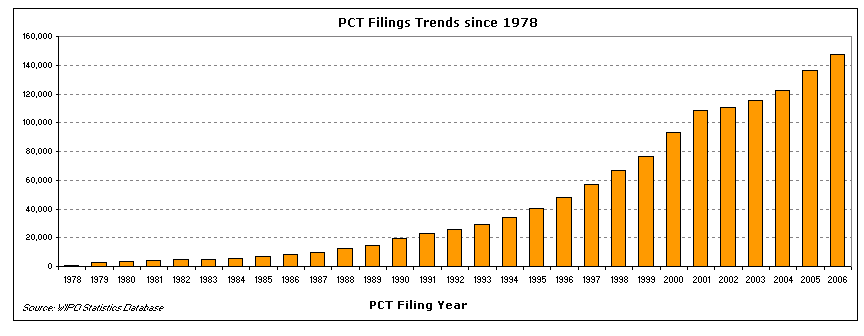
2.2 Top 15 Countries of Origin
The top 15 countries of origin1 are shown in the table below. The most significant changes in 2006 are the rankings of the Republic of Korea (5th, up 1 place) and China (8th, up 2 places). All together, the European Patent Office Member States account for 50,016 PCT international applications, which is an increase of 5.6% over 2005.
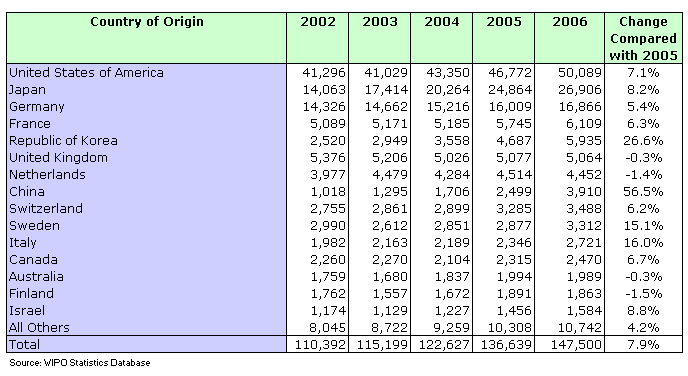
2.3 Top 20 PCT Applicants
The table below shows the top 20 PCT applicants2. In 2006, 231,000 applicants3 (including inventors) used the PCT system. The position of the first five PCT applicants remained the same as in 2005.
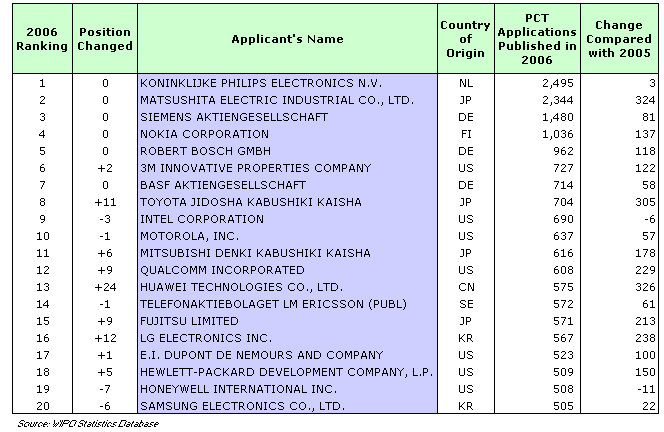
2.4 PCT and Developing Countries
The table below shows the number of PCT international applications filed by applicants from certain developing countries. In 2006, filings from developing countries saw a 32% increase as compared to 2005, representing 8.3% of all international applications filed. *
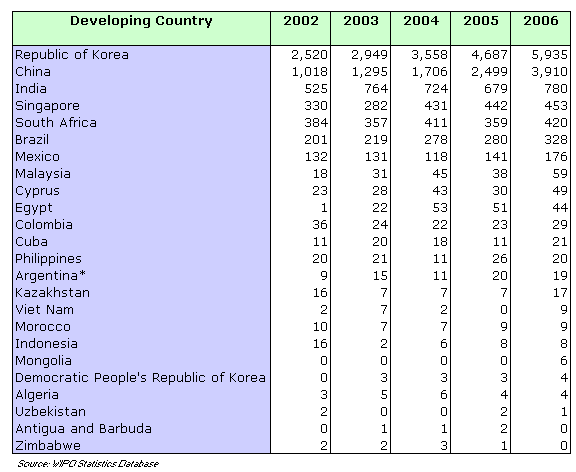
2.5 Languages of Filing
The table below shows the number of PCT international applications filed in 2006 according to the language of filing. A PCT international application may be filed in any language accepted by the relevant receiving Office, but must later be translated into one of the eight official publication languages (Arabic, Chinese, English, French, German, Japanese, Russian and Spanish).
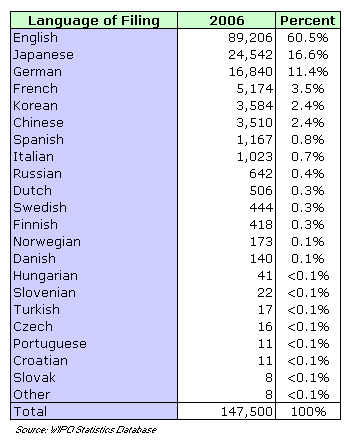
2.6 Classification by Technical Field
The table below shows the technical fields of PCT international applications published in 2006, and compares each total with the corresponding total for the previous years. In this table, PCT international applications are classified according to 30 classifications4 based on the International Patent Classification (IPC) system. As an international application can be counted in more than one technical field, the total of applications by technical field is higher than the total of applications published.
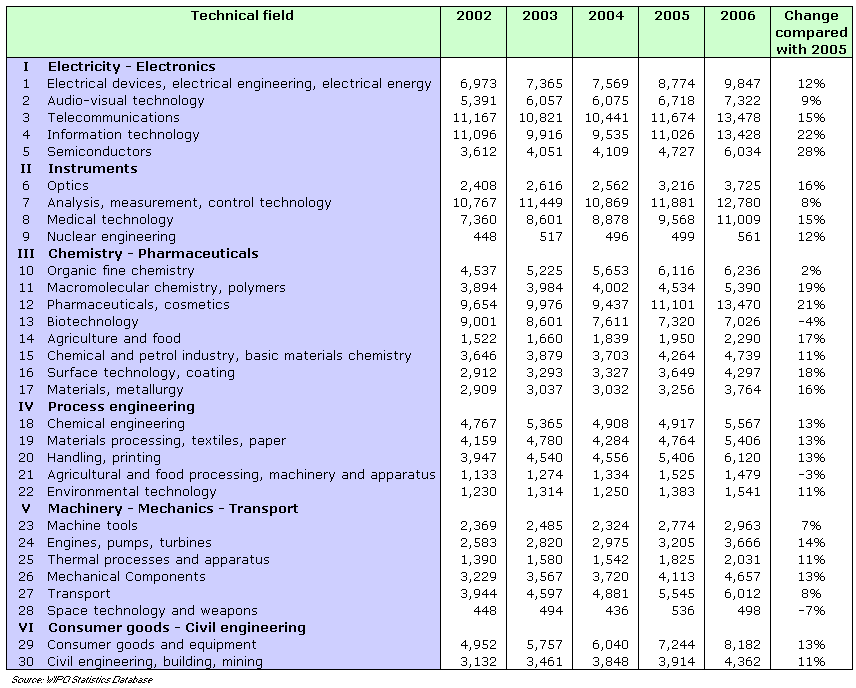
3. Performance of the International Patent System
3.1 Receiving Offices
The table below shows the top 10 receiving Offices in 2006. International applications filed under the PCT are first filed with a receiving Office, which may be a national or regional Office or the International Bureau of WIPO. In 2006, there were 107 Offices acting as PCT receiving Offices.
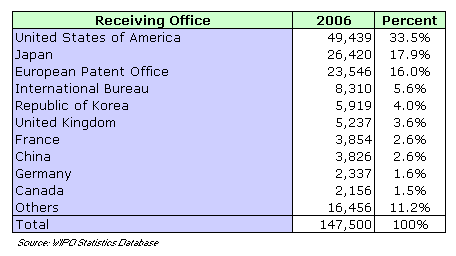
3.2 International Bureau
3.2.1 Workload and PCT Operations Staff
Between 2002 and 2006, the workload of the International Bureau increased by 26.6% while the number of personnel5 processing international applications decreased by 11%.
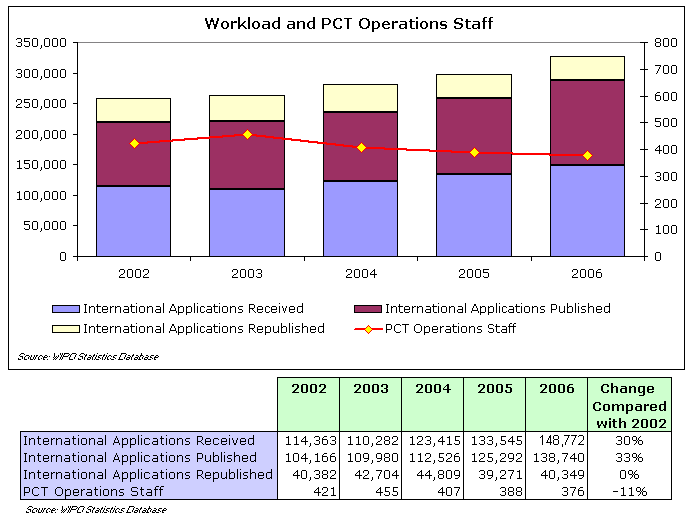
3.2.2 Timeliness of Publication
Publication
The graph below shows the timeliness of publication by the International Bureau. In 2006, 89% of international applications were published within the 2 weeks following the expiration of the 18 months from the priority date, 93% were published within 3 weeks and 94% within 4 weeks.
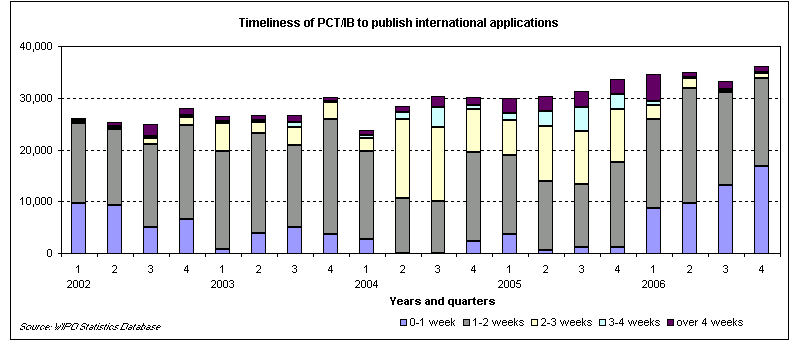
Republication
The graph below shows the timeliness of publication by the International Bureau of the International Search Reports (ISRs) received after the publication of the international applications they relate to. In 2006, 42% were published within 2 months of receipt, 80% within 3 months and 92% within 4 months.
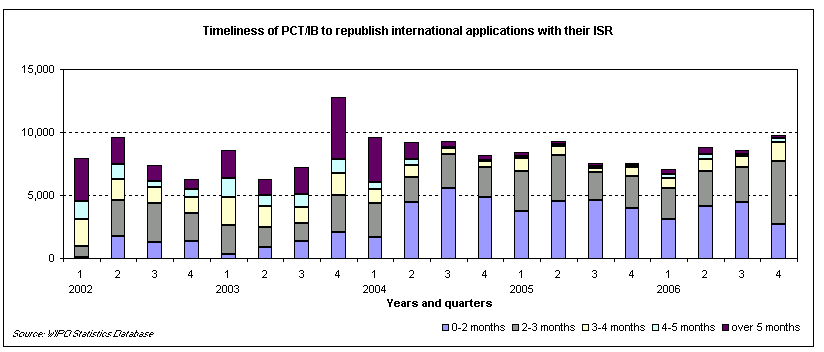
3.2.3 Translation and Terminology
As part of its duties, the International Bureau translates and publishes the abstracts and titles of PCT applications into English and French, and International Preliminary Examination Reports on Patentability (IPRP) into English. In 2006, the International Bureau produced approximately 187,920 abstract translations and 50,836 IPRP translations. The International Bureau has relied heavily on outsourcing as a means of absorbing this considerable workload. In conjunction with the outsourcing activities, the International Bureau has maintained and will continue to maintain an appropriate level of internally produced translations and is implementing a series of control measures to ensure the quality of the externally produced translations.
The objective underlying the International Bureau's translation work is to enhance the patent system's disclosure function by making the technological information embodied in PCT applications accessible in languages other than those in which the original documents were filed.
The graph below shows the distribution of translations done directly by the International Bureau or out-sourced in 2006.
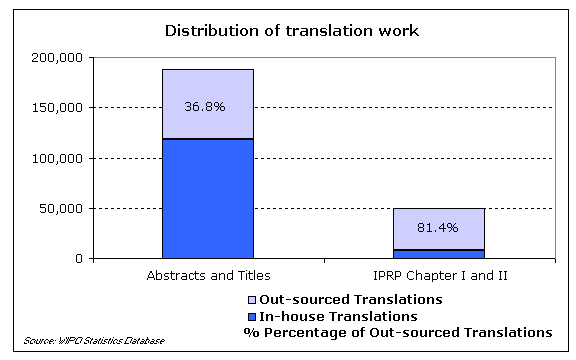
The means of meeting this policy objective must evolve with the technology and the increasingly global reach of the PCT system, marked in particular by rapid growth in North East Asian countries. To meet these challenges, the International Bureau is reorienting its translation activities with a view to creating a multi-lingual search facility to be integrated into PatentScope. As an initial step in the development of this facility, the International Bureau will place more emphasis than in the past on terminology with a view to creating a terminology database in all PCT publication languages that is intended to be the backbone of the multi-lingual search engine.
3.3 International Bureau as Receiving Office (RO/IB)
3.3.1 Filing Trends at RO/IB by Filing Method
The graph below shows the number of international applications filed with the International Bureau as receiving Office with a breakdown by filing method. Three filing methods exist: filings on paper, filings on paper together with the Request Form on a diskette using the PCT-EASY functionality, and fully electronic filings (PDF and XML formats). In 2006, 8,310 international applications where filed at RO/IB of which 53% were filed electronically.
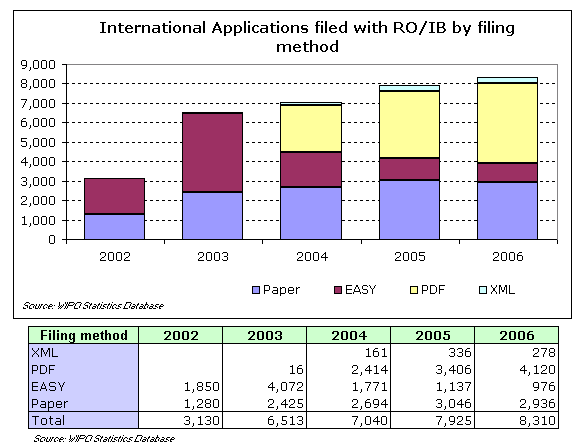
3.3.2 Transmittal of International Applications to the International Bureau as Receiving Office
Where an international application is filed with a receiving Office that cannot accept that application due to the country of residence of the applicant, language of filing or another reason, that international application is considered to have been received by, and forwarded to, RO/IB6. In 2006, RO/IB received 875 such transmittals of international applications, which represents 11% of the international applications it received7.
3.4 International Search
3.4.1 Distribution of International Searching Authorities (ISAs)
The table below shows the number of PCT international applications filed according to their selected International Searching Authority.
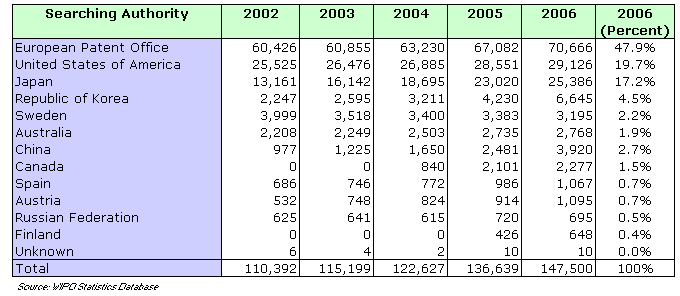
3.4.2 Timeliness
The graph below shows the timeliness of issuance of International Search Reports (ISRs) by International Searching Authorities. In 2006, 56% of the ISRs were received at the International Bureau before 16 months from the priority date and 16% after 20 months from the priority date.
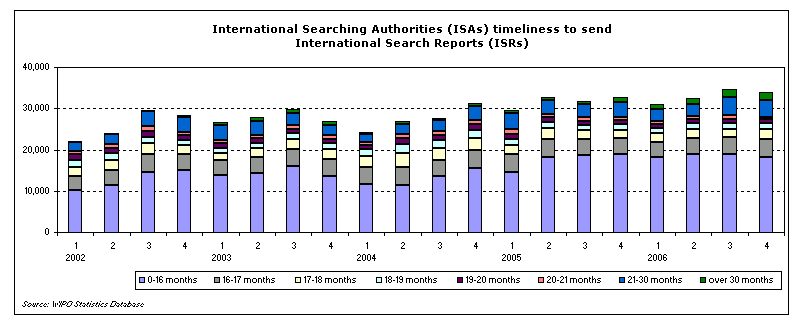
3.5 International Preliminary Examination
3.5.1 Distribution of International Preliminary Examining Authorities (IPEAs)
The graph below shows the number of demands for international preliminary examination since 2002. The decrease is due to modifications of the time limit for entry into the national phase, in force since April 2002, and the introduction in 2004 of the written opinion of the International Searching Authority with is now established with the International Search Report for all PCT international applications.
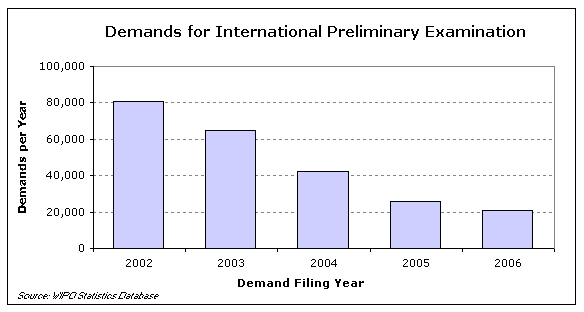
The table shows the number of demands for International Preliminary Examination at each Examining Authority.
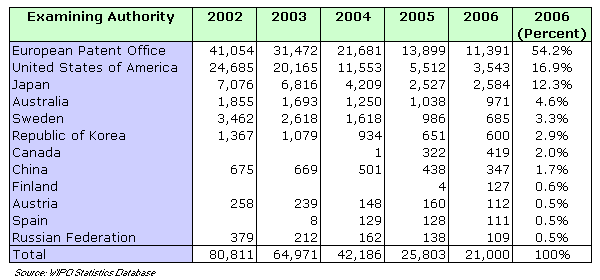
3.5.2 Timeliness
The graph below shows the timeliness of issuance of IPERs and IPRPs chapter II according to the International Preliminary Examining Authority. In 2006, 61% of the IPERs and IPRPs chapter II were received at the International Bureau before 28 months from the priority date and 20% after 32 months from the priority date.
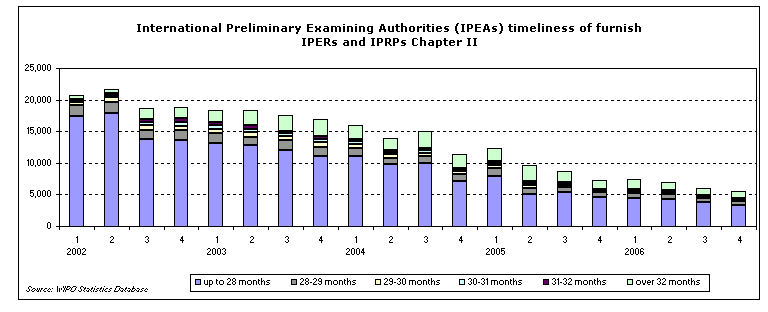
3.6 National Phase Entry
The table below shows the number of PCT national phase entries at 20 Offices. The information is based on data and statistics supplied to WIPO by national patent offices. In addition, individual national phase notifications are available via PatentScope in cases where the Office participates in the WIPO project for collection and dissemination of national phase information.
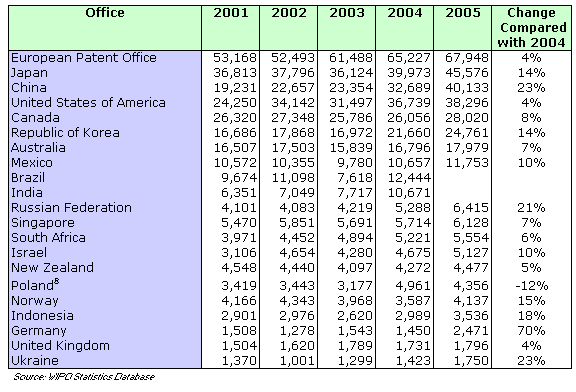
4. PCT and the Electronic Environment
4.1 Electronic Processing of PCT International Applications at the International Bureau
In 2006, the International Bureau completed the deployment of fully electronic processing of international applications using the electronic dossier software (E-dossier), without the need for a paper file. During the course of 2006, the scope of electronic processing was extended to the PCT translation process, and all PCT-related translation work at the International Bureau is now performed in a fully electronic environment with an integrated translation work distribution system within E-dossier.
The deployment of the E-dossier is therefore complete, with the entire business flow at the International Bureau, from receipt and formalities examination to translation and publication being a fully electronic process. E-dossier will continue to evolve and be further developed in order to incorporate improved functions such as fully integrated bibliographic data management, XML processing and terminology. As a result of the E-dossier deployment, the PatentScope database of PCT-related documents and data has been greatly enhanced (see chapter 5 for more details).
4.2 Electronic Exchange of Data between the International Bureau and Offices
Six additional offices, making a total of nineteen9, either in their capacities as receiving Offices and/or International Searching Authorities, have started transmitting record copies, international search reports and other documents to the International Bureau in electronic form, via the PCT Electronic Data Interchange Service (PCT EDI). The aim of PCT EDI is to become a flexible, secure and automated mechanism that enables Offices to exchange bulk data and documents with the International Bureau. The International Bureau at the end of 2006 received more than 50% of all monthly document pages in electronic form.
4.3 Electronic Filing
4.3.1 Continued Shift to E-filing
In 2006, 32.4% of all PCT international applications were filed electronically. In 2006, six new Offices announced that they accept fully electronic filings10 bringing the total to 19 Offices prepared to receive PCT international applications in fully electronic form.
The graph below shows the changing share of filings on paper, filings on paper together with a diskette prepared electronically using the PCT-EASY functionality and fully electronic filings (E-filings) since 1999.
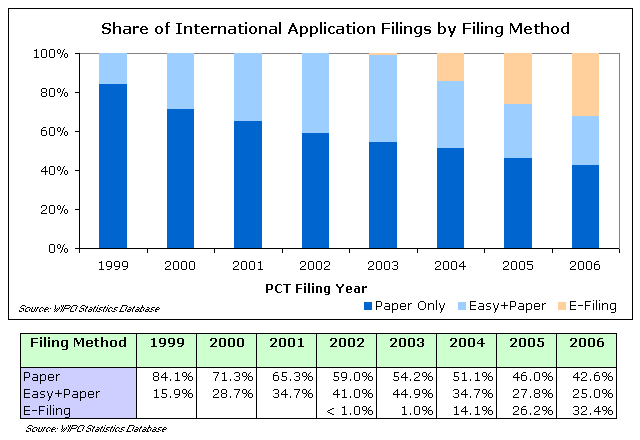
4.3.2 PCT-SAFE software
In 2006, four new versions of the PCT-SAFE (Secure Applications Filed Electronically) client software were released to introduce new functionality, new Offices and other PCT changes.
4.3.3 PCT-ROAD
The PCT-ROAD (Receiving Office Administration) system, a cooperation project between WIPO and the Korean Intellectual Property Office (KIPO), enables electronic filing of PCT international applications on physical media. The PCT-ROAD software has been made available since early 2005 to any Office interested in the system as well as the five pilot Offices11 for their feedback. The system was upgraded in 2006 to provide further functions, such as generating receiving Office forms, deadline monitoring, multi-user support and Spanish language support. By the end of 2006, the PCT-ROAD system had been introduced to 17 PCT receiving Offices.
4.4 Digital Access to Priority Documents
The PCT Assembly, in conjunction with the Assemblies of the Paris Union and the Patent Law Treaty, endorsed a proposal to establish a digital access service for priority documents. This is a voluntary arrangement designed to save applicants from having to produce proof of filing of the original application separately in each state where priority is claimed for Paris Convention filings and to increase the number of cases where priority documents for PCT applications can be provided by the Office of first filing instead of the applicant needing to obtain a certified copy himself. A working group was convened in February 2007 to help establish the procedures, which will build on existing PCT systems for transfer of documents between Offices. A further session of the working group will be held in April 2007.
5. Dissemination of PCT and Patent Information
5.1 PatentScope Web Portal
The PatentScope web portal was launched in July 2005. It gathers together all information concerning WIPOs patent and PCT-related activities, including access to published PCT applications.
In April 2006, PatentScope became the vehicle for electronic publication of PCT international applications, as described below.
PatentScope now provides access to more than 1.2 million PCT international applications published since 1978. The graph below shows the increase in the number of page views on the PatentScope database since the beginning of 2006. The Internet traffic has tripled between January and December 2006.
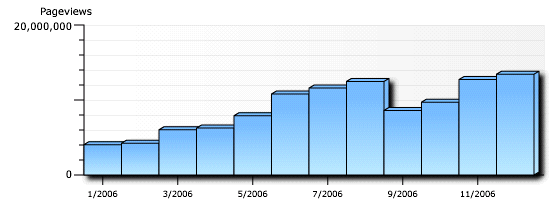
In 2006, several new features were added to the PatentScope database of PCT international applications:
- graphical views of search results;
- RSS feed for search results;
- choice of the text source searched and highlighting of terms found;
- additional data: PCT national phase entries for 27 offices; and
- additional documents: the Notification Concerning Submission or Transmittal of Priority Document (Form PCT/IB/304) and the Notification of the Recording of a Change (Form PCT/IB/306) for changes made between the international publication and the expiration of the international phase.
Other features provide
- Advanced and rapid search facilities, including full-text search for applications published in English, French, German and Spanish since April 1998;
- the complete collection of published PCT applications from the first publication in 1978 to the present day;
- access to new PCT applications on the publication date every week;
- facility for printing and/or downloading complete documents in a choice of formats;
- the latest bibliographic data available on record at the International Bureau, including changes since publication; and
- access to status information, published documents and file contents through a single system.
Improved services to patent information providers
The International Bureau has been working to improve the dissemination of PCT-related data via private and public patent information providers. In 2006, a pilot project was started to test the delivery of PCT data over the Internet. Participants in the pilot project can now download, each week on publication date, the complete PCT publication including page images and full-text data produced by the International Bureaus in-house OCR (Optical Character Recognition) software.
5.2 Exclusive Electronic Publication of PCT Applications
Since 1 April 2006, international publication of PCT international applications and any republications of previously published international applications takes place in electronic form, and the International Bureau no longer transmits a paper copy of the published international application to the applicant.
Published international applications can be viewed, downloaded or printed directly from PatentScope. The international publication can be found by searching on the international application number, publication number, or any other search criteria supported by PatentScope. Weekly indexes of published applications can also be browsed online.
5.3 New Internet Resources for PCT Applicants
Since January 2006, the PCT Applicants Guide is a web-based publication, available free-of-charge and updated weekly. It is available at: www.wipo.int/pct/guide/en/.
In addition, several new Internet services were launched in 2006:
- the PCT Time Limit Calculator;
- the Repository for Information on Emergency Preparedness Measures, and
- the PCT Glossary.
5.4 Aggregate Patent Statistics
The International Bureau has improved the collection of patent statistics and established a patent statistics database. In 2006, the International Bureau published the first edition of the WIPO Patent Report12 which contains indicators and explanations of the main trends in worldwide patent activity.
In addition to analytical reports and Internet-based queries for aggregate data, WIPO now publishes aggregate statistics covering patents since 1883 and patent filings (including PCT national phase entries) and grants by country of origin in a choice of electronic formats.
5.5 Eighth Edition of the IPC
The eighth edition of the International Patent Classification (IPC) came into force on 1 January 2006. Since this date, all published PCT applications are classified using the eighth edition of the IPC.
An IPC master classification database (MCD) has been created for the purpose of collecting classification data of published documents so that all patent documentation can be searched using a single edition of the IPC. Since the end of May 2006, the entire collection of published PCT applications available through PatentScope are reclassified according to the 8th edition of the IPC, based on the reclassification information made available from the MCD.
6. Changes in the PCT Legal Framework
6.1 Changes in 2006
6.1.1 Amendments to PCT Regulations
In October 2005, the PCT Assembly approved a number of amendments, which entered into force on 1 April 2006, concerning the following issues:
- international applications and the PCT Gazette may be fully and exclusively published in electronic format (see Chapter 5 for more details);
- addition of Arabic as a language of publication;
- exceptions to the all-inclusive designation system; and
- publication of declarations relating to national requirements as part of the international application.
6.1.2 Other Changes in 2006
- The former State Union of Serbia and Montenegro (country code: YU) ceased to exist on 3 June 2006. The International Organization for Standardization has assigned the Republic of Serbia the two-letter code of RS and the Republic of Montenegro the two-letter code ME;
- The Assembly amended, with effect from 12 October 2006, the Schedule of Fees annexed to the PCT Regulations to incorporate a new fee reduction for international applications filed in electronic form where the entire application, including the request, is in a non-character coded format.
Further noteworthy developments in 2006 include the following:
- The PCT Assembly appointed the Nordic Patent Institute (NPI), comprising the patent offices of Denmark, Iceland and Norway, as an International Searching and Preliminary Examining Authority under the PCT. The appointment will take effect from the date of entry into force of the necessary agreement between NPI and the International Bureau;
- The Member States reviewed the status of the PCT reform process. The Assembly agreed that there would be a further session of the Working Group on the Reform of the PCT before the 2007 session of the Assembly to consider outstanding proposals for the reform of the PCT; and
- The Member States noted a report concerning a new reporting system agreed by the Meeting of International Authorities Under the PCT to assist International Authorities in understanding and benefiting from quality reports sent to them by other Authorities under the quality framework set out in Chapter 21 of the PCT International Search and Preliminary Examination Guidelines.
6.2 Changes in 2007
6.2.1 Amendments to PCT Regulations
In October 2005 and 2006, the PCT Assembly approved a number of amendments, which will enter into force on 1 April 2007, concerning the following issues:
- missing elements and parts of the international application;
- restoration of the right of priority;
- rectification of obvious mistakes;
- addition of patent documents from the Republic of Korea to the PCT minimum documentation;
- minimum requirements for International Searching and Preliminary Examining Authorities;
- changes to physical requirements of the international application to assist optical character recognition; and
- clarification of language-related requirements of the international application.
6.3 PCT Training
Around 180 seminars and presentations about the use and advantages of the PCT system, and promotion of accession to it, were given by officials of the International Bureau in the following languages: Arabic, Chinese, English, French, German, Indonesian, Japanese, Portuguese and Spanish.
The seminars and presentations were held in the following 40 countries: Australia, Belgium, Brazil, Bulgaria, Canada, China, Cuba, Denmark, Ecuador, Egypt, Finland, France, Germany, Honduras, Indonesia, Ireland, Israel, Italy, Japan, Kenya, the Republic of Korea, Lithuania, Libya, Malaysia, Mexico, Morocco, the Netherlands, Nigeria, Panama, Peru, El Salvador, Slovenia, South Africa, Spain, Sweden, Switzerland, Tanzania, the United Kingdom, the United States of America and Zimbabwe.
7. PCT Contracting States
During 2006, 7 new Contracting States became bound by the PCT, namely: Bahrain (from 18 March 2007), Lao Peoples Democratic Republic, Honduras, Malaysia, Malta (from 1 March 2007), El Salvador and Guatemala - bringing the number of States which had acceded to the PCT by 31 December 2006, to 136, as follows:
| AE United Arab Emirates | EE Estonia (EP) | LC Saint Lucia | PT Portugal (EP) |
| AG Antigua and Barbuda | EG Egypt | LI Liechtenstein (EP) | RO Romania (EP) |
| AL Albania1 | ES Spain (EP) | LK Sri Lanka | RS Serbia |
| AM Armenia (EA) | FI Finland (EP) | LR Liberia | RU Russian |
| AT Austria (EP) | FR France (EP)2 | LS Lesotho (AP) | Federation (EA) |
| AU Australia | GA Gabon (OA)2 | LT Lithuania (EP) | SC Seychelles |
| AZ Azerbaijan (EA) | GB United Kingdom (EP) | LU Luxembourg (EP) | SD Sudan (AP) |
| BA Bosnia and | GD Grenada | LV Latvia (EP) | SE Sweden (EP) |
| Herzegovina1 | GE Georgia | LY Libyan Arab | SG Singapore |
| BB Barbados | GH Ghana (AP) | Jamahiriya | SI Slovenia (EP)2 |
| BE Belgium (EP)2 | GM Gambia (AP) | MA Morocco | SK Slovakia (EP) |
| BF Burkina Faso (OA)2 | GN Guinea (OA)2 | MC Monaco (EP)2 | SL Sierra Leone (AP) |
| BG Bulgaria (EP) | GQ Equatorial | MD Moldova (EA) | SM San Marino |
| BH Bahrain (from | Guinea (OA)2 | ME Montenegro | SN Senegal (OA)2 |
| 18 March 2007) | GR Greece (EP)2 | MG Madagascar | SV El Salvador |
| BJ Benin (OA)2 | GT Guatemala | MK The former | SY Syrian Arab |
| BR Brazil | GW Guinea-Bissau (OA)2 | Yugoslav Republic | Republic |
| BW Botswana (AP) | HN Honduras | of Macedonia1 | SZ Swaziland (AP)2 |
| BY Belarus (EA) | HR Croatia1 | ML Mali (OA)2 | TD Chad (OA)2 |
| BZ Belize | HU Hungary (EP) | MN Mongolia | TG Togo (OA)2 |
| CA Canada | ID Indonesia | MR Mauritania (OA)2 | TJ Tajikistan (EA) |
| CF Central African | IE Ireland (EP)2 | MT Malta (EP) | TM Turkmenistan (EA) |
| Republic (OA)2 | IL Israel | (from 1 March 2007) | TN Tunisia |
| CG Congo (OA)2 | IN India | MW Malawi (AP) | TR Turkey (EP) |
| CH Switzerland (EP) | IS Iceland (EP) | MX Mexico | TT Trinidad and Tobago |
| CI Côte d?Ivoire (OA)2 | IT Italy (EP)2 | MY Malaysia | TZ United Republic of |
| CM Cameroon (OA)2 | JP Japan | MZ Mozambique (AP) | Tanzania (AP) |
| CN China | KE Kenya (AP) | NA Namibia (AP) | UA Ukraine |
| CO Colombia | KG Kyrgyzstan (EA) | NE Niger (OA)2 | UG Uganda (AP) |
| CR Costa Rica | KM Comoros | NG Nigeria | US United States of |
| CU Cuba | KN Saint Kitts and | NI Nicaragua | America |
| CY Cyprus (EP)2 | Nevis | NL Netherlands (EP)2 | UZ Uzbekistan |
| CZ Czech Republic (EP) | KP Democratic People?s | NO Norway | VC Saint Vincent and |
| DE Germany (EP) | Republic of Korea | NZ New Zealand | the Grenadines |
| DK Denmark (EP) | KR Republic of Korea | OM Oman | VN Viet Nam |
| DM Dominica | KZ Kazakhstan (EA) | PG Papua New Guinea | ZA South Africa |
| DZ Algeria | LA Lao People's | PH Philippines | ZM Zambia (AP) |
| EC Ecuador | Democratic Republic | PL Poland (EP) | ZW Zimbabwe (AP) |
1 Extension of European patent possible.
2 May only be designated for a regional patent (the national route via the PCT has been closed).
Where a State can be designated for a regional patent, the two-letter code for the regional patent concerned is indicated in parentheses (AP = ARIPO patent, EA = Eurasian patent, EP = European patent, OA = OAPI patent).
PCT Contracting States in 2006
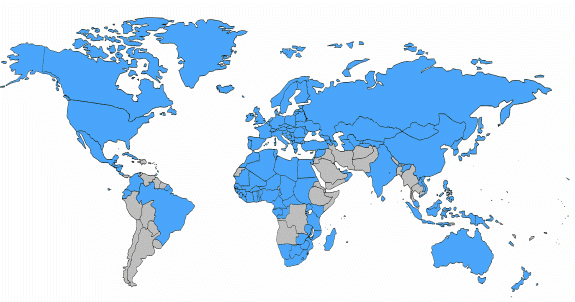
Note: This list includes all States that have adhered to the PCT by the date shown in the heading. Any State indicated in bold italics has adhered to the PCT but will only become bound by the PCT on the date shown in parentheses; it will not be considered to have been designated in international applications filed before that date. Note that even though the filing of a request constitutes under PCT Rule 4.9(a) the designation of all Contracting States bound by the PCT on the international filing date, for the grant of every kind of protection available and, where applicable, for the grant of both regional and national patents, applicants should always use the latest versions of the request form (PCT/RO/101) and demand form (PCT/IPEA/401) (the latest versions are dated April 2006) or, if filing the request using the PCT-EASY features of the PCT-SAFE software, the latest version of that software (which is available at: https://www.wipo.int/pct-safe). The request and demand forms can be printed from the web site, in editable PDF format, at: https://www.wipo.int/pct/en/forms/, or obtained from receiving Offices or the International Bureau, or, in the case of the demand form, also from International Preliminary Examining Authorities.
8. More Resources on the Internet
The following patent resources are available on the WIPO Internet:
|
PATENTSCOPE® - WIPOs portal for information on Patents and the PCT System |
|
|
Information on the PCT System |
|
|
Patent Search - Search PCT International Applications and view/download complete patent applications and related documentation. |
|
|
Law of Patents - includes current and emerging issues related to patents, information on WIPO-administered treaties, access to national/regional patent laws, patent law harmonization. |
|
|
PCT Statistics - monthly and yearly statistics on the PCT system, including comparative list of applicants and details of the indicators included in this report. |
1 The country of origin of an international application is the country of residence of the first-named applicant in the international application.
2 Based on the number of PCT international applications published in 2006.
3 An application typically has multiple applicants, thus the number of applicants is greater than the number of PCT international applications.
4 Created by OST, INPI and Fhg-ISI.
5 Number of staff directly involved in processing, translating and publishing PCT international applications.
6 Transmittal under Rule 19.4 of the PCT Regulations.
7 Based on the actual date of receipt at RO/IB and not the International Filing Date.
8 Poland became party to the European Patent Convention in March 2004.
9 Australia, Canada, China, Denmark, European Patent Office, Finland, France, Germany, Japan, Mexico, the Netherlands, Poland, the Republic of Korea, Slovakia, Spain, Sweden, United Kingdom, United States of America and Viet Nam.
10 Germany, Japan, Malaysia, Philippines, Poland and Romania.
11 Egypt, Israel, Malaysia, Philippines and Viet Nam.
12 Available at https://www.wipo.int/ipstats/en/statistics/patents/